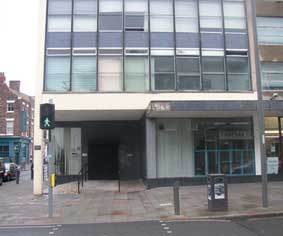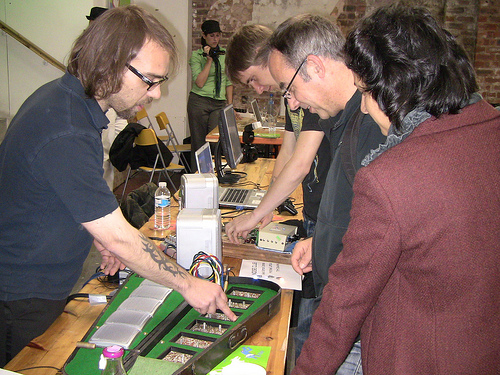It didn’t, I just needed a title I could buzz off. A quick proviso – this may turn into a rant and there is to much history for me to go into too much detail, so you’ll just have to take what I say as read or exaggerated slightly as the case may be – but hopefully you’ll get my point.
Last Night was the first Cultural Forum organised by Bido Lito Magazine – The forum had been called after a number of arts/clubs had been asked by the council to pay full whack rates rather than the 20% discretionary rates which they had received the year before – this situation had been handled badly by the council or their subcontractor and so some organisations were receiving demands for money which they just didn’t have. The forum wasn’t just called for these reasons but also because venues in the city have been hit with noise abatement orders making it difficult for them to operate
Bido Lito! Hosts CULTURE FORUM – A Public Event Seeking To Ensure Grassroots Creative Culture’s Stake In Liverpool’s Future…
We were asked to read the Sith attached aka the Strategic investment Framework as a prelim to the meeting. http://www.liverpoolvision.co.
The forum was very centred on the Rates issue and as I was reminded by Jayne Casey after the meeting that when we used to organise public meetings for the Independent Biennial back in circa 1999, the discussions weren’t about rates but about life, art, philosophy, politics and the artists raged against the system, but we would have 2-300 people turn up. In the short term this led to the start of the Independent District now renamed by Liverpool Vision as the Baltic Triangle.
The forum highlighted gaps in information provision (i.e. communication)
There was a time when http://artinliverpool.com used to handle information sent via the council but since the site has been handed over to VAIL to run this hasn’t been taking place, no wonder really. You could rely on Ian and Mina to turn up to events, to help people with useful information as they believed in the power of creativity they weren’t just being paid to do a job. This has led to a loss of service maybe not one that people recognised but a loss all the same. There was even the Arts and culture Network which was run by the Liverpool Council for Voluntary services which was another place that creatives could go to for information, help advice but the Network closed a number of years ago as funding dried up.

In days of old (as I seemed to start every sentence in the conversation I had with Craig prior to the culture Forum) when I used to run the North west Arts Board office/Arts Council Office (more detail here) there was support of the kind being sought last night – the communication lines were more straight forward. An email to me meant an email out to the wider creative community, a topic of heated conversation and a poster on the window.
Artist Paul Rooney – “I remember using the office for photocopying, and using the computer, when such things were difficult to access, and the library of publications useful to artists applying for funding was a great help. So the available facilities were a strength, as was the opportunity to bump into other city based artists and have a chat, which didn’t happen anywhere else apart from the odd private view.” from Nerve Jan 2013
Back then communication was easier, the lines of communication were long standing and set, but these days when communication is at the touch of a button on your mobile there is no excuse for poor communication but maybe it is the lines of communication that have become unclear. Will a post to Facebook be OK, a Tweet should suffice – What? No! is that not good enough.
Again it comes back down to a place, a hub, a centre of connectivity – where one message is spread far and wide, where the message sent is trusted.
This loss of networks, hubs, centres of creativity, whatever you want to call them has led to gaps in knowledge of the creative community as to where they can go to seek out information, support, or even a forum to discuss issues which matter to them in their city.
Maybe last year – who can remember but it was between when Ian and Mina stepped down in charge of artinliverpool.com and VAIL taking it up I had a terrible urge to create a website which would attempt to do what they had done before me. I created a site on a test server where I could experiment with it and see if I could get it to work well enough to make it live – it was The Crux a site that got to the heart of the matter, a pivot point – it was to serve the creative community in the way that was very much highlighted last night. Or in my own way to seek to address the needs from a community I love. Alas The Crux was not meant to be as I dumped it when i heard that artinliverpool.com were starting up again – older and wiser now I should have kept it live and ran with it.
The event for me raised a number of questions
1. Where were the representatives of the larger organisations?
Whoever we think of, they should have been at this meeting, Tate Private View or not – the work will still be on the walls tomorrow at the Tate. You the non attenders were the very people who these mainly young creatives can learn so much and yet you weren’t there to lead the way. Although the chair of the Cool Organisations was there – Julian I think his name was.
2. Where are the present day networks, organisations or groups?
I/we/you used to be able to reach out a hand, walk across a road or download a list of small arts organisations or artists studios in Liverpool – today you can’t do that – instead you search a myriad of websites – how much harder it is these days – no joined up thinking.
3. Planning
This really should have been discussed in more detail – how the city of Liverpool is becoming homogeneous – all cities look the same these days and we should try and address this more fully.
I’ll try and wrap up now.
Check this out as a piece of joined up thinking from years ago http://goo.gl/maps/yB7vD a Google map listing Arts Galleries in Liverpool or this now empty Art in Liverpool Google Calendar These things are not hard but require some joined up thinking – so check out the Liverpool Digital Events calendar which a group of us keep up to date. None of this is hard but requires working together – conversation.
This does kind of lead me onto another thought, a possibility, a way of getting the creatives to work together better, I believe the phrase is “a more joined up approach” and I believe that is through another Hack4Culture event that this could take place. Hopefully another Hack4Culture event will most probably be taking place in the next couple of months. You can read about the last one here
There is much left unsaid as I could go on forever, if you feel challenged by anything that I say – then good do be challenged and challenge me back.
Comments are open so FEEDBACK or miss another boat.

